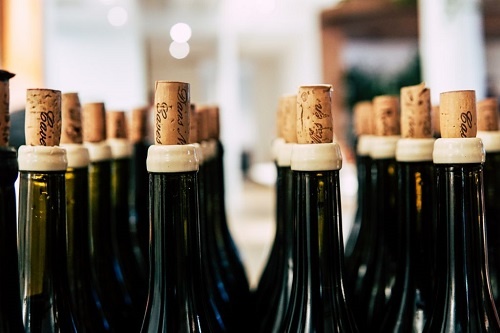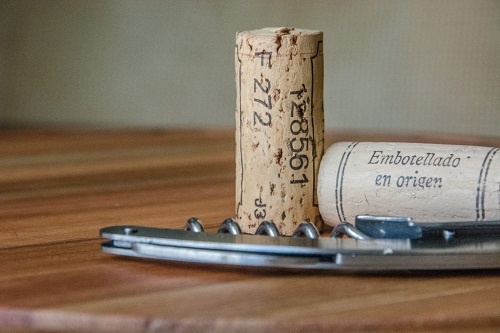Wine, the elixir of Bacchus, is liquid pleasure. Just one glass has the power to arrest and mesmerize the senses--perhaps taking you to a fond memory of another place and time or making your present a special moment... Wine flirts with the palate with flavors that can be quick to come or restrained and surprising.
Screw It, Or Put A Cork In It
by Matthew Lorman
Wine, the elixir of Bacchus, is liquid pleasure. Just one glass has the power to arrest and mesmerize the senses--perhaps taking you to a fond memory of another place and time or making your present a special moment... Wine flirts with the palate with flavors that can be quick to come or restrained and surprising. Wine brings on the subtle seductiveness of romance. There is only one thing that stands in the way between you and enjoying a bottle of wine. Before you can begin to enjoy wine’s pleasures, you have to get it open. Don’t forget that setting the mood is key. Depending on what you are looking for, a quick screw might do. But, if you’re looking for the seductive romance of slowly easing your way into a bottle of wine, reach for your corkscrew, twist, pull, and wait for the “pop.”

Corks have been used to seal wine since the 1400s, with origins in Europe. Fast-forward a few years, and we are now seeing the future of wine preservation: the screwcap. Bottles of wine are now being sealed with corks, screw caps, and countless other enclosure options, leaving people wondering which method is best for their wine. Let’s explore the benefits and drawbacks of each type of these enclosures.
Put a Cork In It
If you are looking to enjoy a special night with a special someone, perhaps a wine with a cork top is the way to go. Part of the traditional allure of wine is in the cork, and the affair involved with opening the bottle. The cork type will help you determine when it is the right time to open it. There are three types of corks used to seal wine:
Natural corks are made from the cork oak tree. These corks are best for aging wine long term (10-25 years). [Read more about aging wine here.]
Synthetic corks are made from petrochemical-based plastics or plant-based plastics. These corks are commonly found in wines not meant to age. They are solid cylinders and do not allow for air to naturally flow in and out of the wine bottle. Wines sealed with synthetic corks should be drunk within one to two years of release.
Agglomerated corks are hybrid corks made with natural cork bark scraps, cork dust, and synthetic materials. These corks are best for wines with medium-aging (3-5 years) as very little air gets into the bottles.
Benefits of Corks
Here is some good news for the planet: all types of corks are recyclable! Toss them into your recycling bin along with your wine bottle after use.
In addition, most corks are made from a natural resource! Most cork oak trees can live up to 200 years old and are harvested many times throughout their lifespan. That means that every time corks are made, producers only need to harvest the outer bark of the cork oak tree, leaving the rest of the tree completely intact.
And as already mentioned above, corks (natural and agglomerated) are considered the best sealants for aging wine. They’re malleable enough to fit inside a bottle of wine, creating a seal and protecting it from the elements, all while allowing the wine to age properly. Natural corks, in particular, are made up of small honeycomb-like cells that contain tiny air pockets. The seal created by cork is water-tight, however, these tiny air pockets are responsible for allowing a small amount of air into the bottle, which allows the aging process to begin and the flavors and aromas of the wine to develop over time. Most top-rated producers in premier wine regions use natural corks for wines with aging potential due to their proven track record. You'll find that natural cork is what allows Bordeaux and Burgundy wines to age gracefully into their old age.
Drawbacks to Corks
One of the major drawbacks to corks is that the quality levels vary from producer to producer. If corks are not processed properly using strict hygienic practices, they can be tainted with something called trichloroanisole (TCA). Trichloroanisole, difficult to pronounce but easy to detect in a bottle of wine, is what gives so-called “corked” wines the off-putting smell of a wet basement or moldy cardboard. Additionally, because corks are a natural product, the rate at which they breathe varies. Finally, cork is also, generally, more expensive compared to their twist-off counterparts, contributing to the overall price of a wine.

(un)Screw It, Instead
If you are looking for something quick and easy, screw caps are the way to go. Once thought of with disdain, screw-capped wines are coming into vogue and increasingly available in the market. Screw caps have been used in wine since the 1960s, becoming popular later on in the 1980s during a period of time when there was an abundance of poor quality corks that contained TCA. Winemakers, throughout the world, had enough of these tainted wines and broke up with cork altogether starting an enduring love affair with screw caps. Australia and New Zealand led the way in the promotion of screw caps, although other countries with a history rooted in winemaking, like France and Italy, are starting to come around to the idea.
Benefits of Screw Caps
Have you ever tried to open a bottle of wine and realize you forgot the corkscrew? Fret not, this is where screw caps save the day. Screw caps offer a more affordable way to seal wine bottles that require just a quick twist of the wrist to get the juices flowing. At just a fraction of the cost of traditional cork, producers are singing praises for these closures while also limiting the risk of TCA. They don’t break when you open them and are the perfect closure for retaining freshness, particularly in aromatic white wines and those that are intended to be enjoyed shortly after bottling.
Drawbacks to Screw Caps
Just like cork, screw caps come in varying quality levels. The most commonly known, good quality brand is the Stelvin® enclosure. Screw caps are recyclable but not biodegradable, generally being made from non-renewable resources. Unlike cork, which has micropores that allow air to pass through, it is difficult for oxygen to interact with the wine sealed by a screw cap thus slowing or preventing the aging process. However, screw cap technology is ever-evolving, and there are a small number of these enclosures available in the market that have mimicked the micropores of corks. Curious winemakers are beginning to experiment with aging their cellar-worthy wines in screw-capped bottles.

Finally, there is a stigma that screw-capped wines are of inferior quality when compared to their cork-sealed counterparts. As winemakers look to more affordable options to keep their wines accessible to a broader market, this stigma may eventually disappear.
So Which One is Better?
There are no hard and fast rules as to whether a cork or a screw cap is the better option when it comes to selecting wine. “Which one is better?” is perhaps best answered with another question: “What are you planning to do with the wine?”If you’re planning to age the bottle, then a cork-sealed wine, preferably with natural cork, may be better. If you’re looking to quickly get the contents of the bottle in a glass, then the screw-capped wine may be the option you go for.
